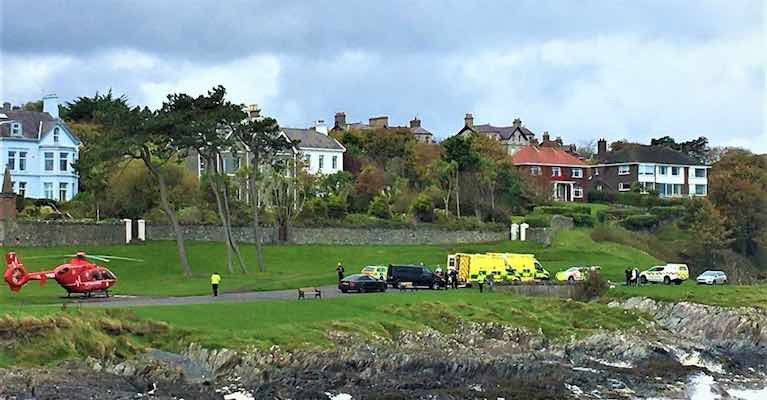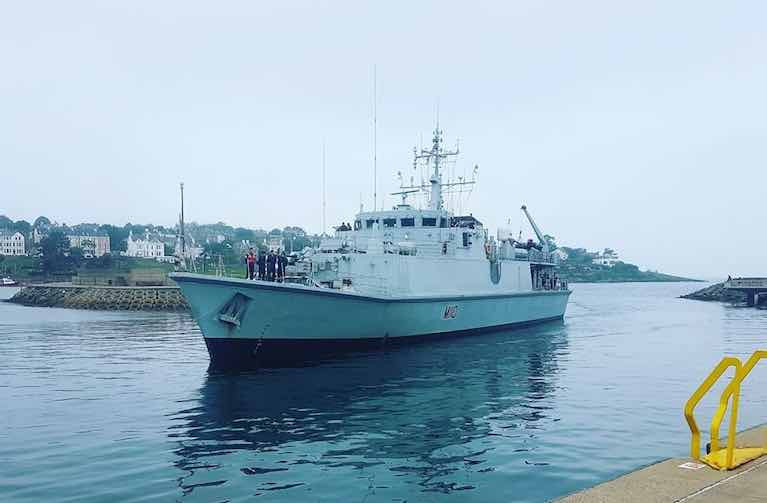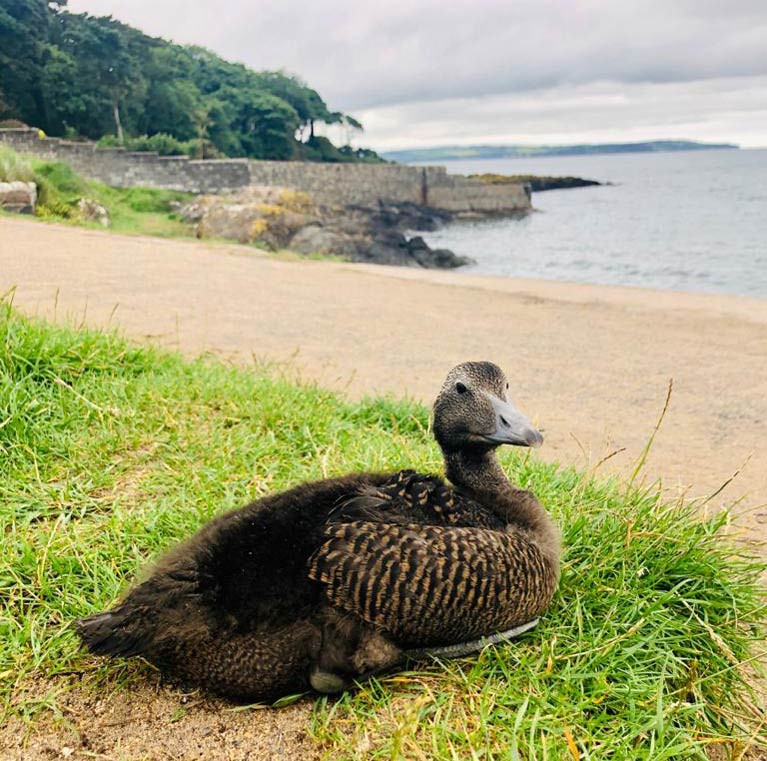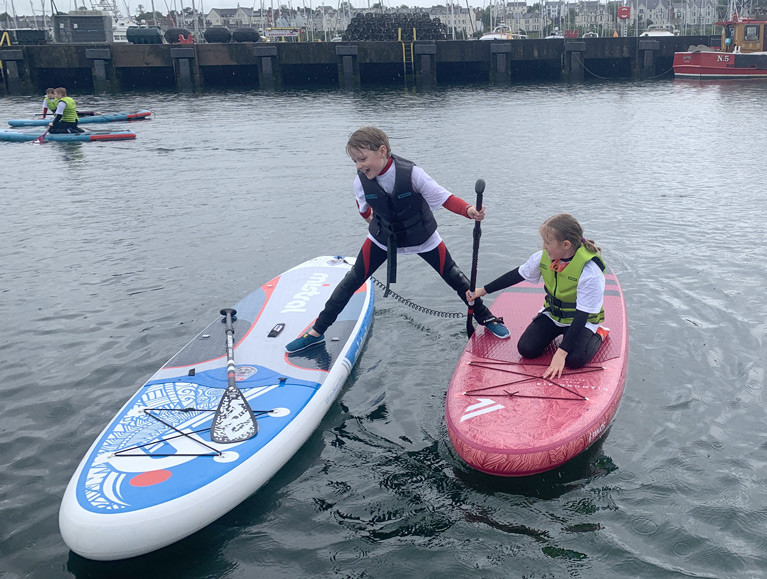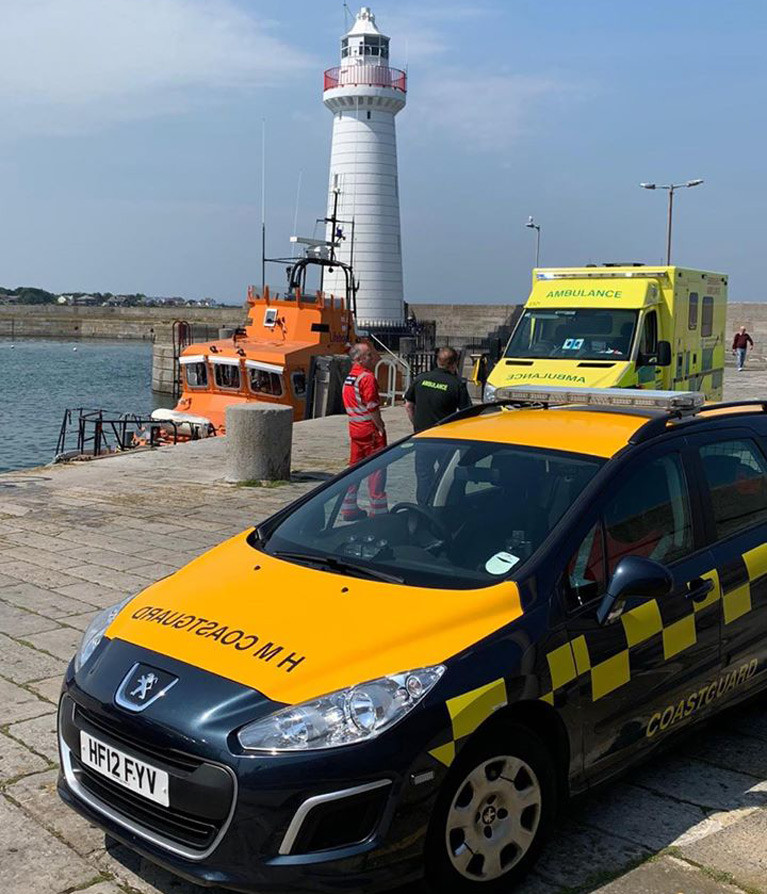Displaying items by tag: Bangor
Two Swimmers Rescued From Belfast Lough During Christmas Day Swim
Two open water swimmers who got into difficulty during their Christmas Day swim near Bangor in Northern Ireland have been praised for wearing kit that made it easier to find them.
The pair were reported to be having problems in Belfast Lough off Grey Point Fort in Helen’s Bay by a passer-by who called 999 and asked for the coastguard.
Bangor and Portaferry Coastguard Rescue Teams and Bangor RNLI’s lifeboat were both sent, along with paramedics, Air Ambulance NI and PSNI.
One of the swimmers made it to shore by themselves and was treated by coastguard personnel, while the other was rescued from the water by Bangor lifeboat. Both were handed into the care of the NI Ambulance Service.
Jude McNeice of HM Coastguard said: “The fact that both swimmers were wearing tow floats made it much easier to locate them.
“Even the most experienced swimmer can be caught out by a change in the conditions and we’d always urge open water swimmers to make sure they have kit like this before taking to the water. It could save your life.”
Commenting on the incident on social media, Bangor RNLI said: “On Facebook there are a number of comments critical of the two swimmers, but Bangor RNLI won’t be joining in.
“We can be pretty sure the casualties did not leave home planning to be reckless and requiring rescue; they just got into difficulty and almost paid the ultimate price. They have our amazing rescue services to thank for still being with us.”
Bangor Waterfront Project Envisages Development of Ballyholme Yacht Club as Watersports Centre
Investment in a two-mile stretch of Bangor Waterfront on Belfast Lough is part of the recently announced £1billion Belfast City Deal funding. Plans already published for Bangor Waterfront aim to “reconnect the town with the sea through a range of attractions and experiences”. It involves the provision of high-quality public spaces and the regeneration of Bangor Marina and Ballyholme Yacht Club. The plans say that the club “has been identified as the preferred location within Northern Ireland for major sailing and water sports events by the Royal Yachting Association”.
 Ballyholme Yacht Club as it is today - the club has been identified as the preferred location within Northern Ireland for major sailing and water sports events by the Royal Yachting Association
Ballyholme Yacht Club as it is today - the club has been identified as the preferred location within Northern Ireland for major sailing and water sports events by the Royal Yachting Association
Some of the scheme, which has been designed by Hemingway Design and Aecom, has already caused controversy. There are concerns that the character of Kingsland, the only substantial green area at Ballyholme, will be lost with the development of “tourism accommodation pods, café kiosks and a skate park (now an Olympic sport) set in landscaped gardens.
"Ballyholme Yacht Club has been identified as the preferred location within Northern Ireland for major sailing and water sports events"
There is also the potential for a small cluster of high-quality residential developments to the south of the area”. And the graphics in the Bangor Waterfront document show a landscaped area replacing the very large car park near the Club which may be to the detriment of competitors in large events hosted by BYC. The plans continue “The redevelopment of BYC would provide Bangor with a world-class facility for water sports and the ability to host international events”.
 A graphic of the proposed Waterfront development at Bangor, County Down
A graphic of the proposed Waterfront development at Bangor, County Down
The Club refers to the proposed new building as Ballyholme Yacht Club and Watersport Centre, to reflect its increased range of activities, which now include diving, SUPs, kayaking, and swimming.
 Sea swimming on Belfast Lough at Ballyholme Yacht Club
Sea swimming on Belfast Lough at Ballyholme Yacht Club
 The tennis courts at Kingsland
The tennis courts at Kingsland
It is understood that the Council will publicise opportunities to engage in the whole scheme and that everyone with an interest in the scheme can become involved. Subject to financial/ project approvals and planning permission, work ‘on the ground’ will begin in 2023 (phased), with the projects delivered over 8 to 10-years.
 Kingsland is the only substantial green area at Ballyholme
Kingsland is the only substantial green area at Ballyholme
David McMullan, who leads a small ‘redevelopment’ sub-committee reporting to the Executive Committee of BYC, has explained the Club’s position “On Wednesday 15th December it was announced that £1 billion funding for the Belfast Region City Deal had been approved. This is the first City Deal to be signed for Northern Ireland. Ards and North Down Borough Council (ANDBC) had submitted their plans for the Waterfront Redevelopment in Bangor as part of this Regional City Deal, which included the redevelopment of BYC, and we understand proposed plans have been reviewed and approved in principle. We expect to hear early in the New Year details of the funding for ANDBC’S plans and then be able to conclude discussions with ANDBC on how that will impact the proposed redevelopment of BYC. We will then present this to the membership for discussion and hopefully approval”.
The £40m funding for Ards and North Down Council will be matched by its contribution of £20m from the Council.
Queen's Parade on Bangor Seafront Set for Redevelopment
Queen's Parade on the seafront in Bangor on Belfast Lough has been largely derelict for well over twenty years. But just this week the Ards and North Down Borough Council approved a £50m scheme for large scale redevelopment of the site enclosed by Lower Main Street, Queen's Parade and Southwell Road. As with the names of many streets in Bangor during the Victorian era, names were changed, and Sandy Row became Queen's Parade.
The laying of the railway in 1865 from Belfast meant that inexpensive travel was possible, and Bangor soon became a fashionable resort for Victorian holidaymakers thus making the seafront a popular gathering place. The small beach and bay which preceded the Marina were busy with visitors. But the emergence of out-of-town shopping centres was the beginning of the end of an era in Bangor and with the coming of inexpensive foreign holidays, ease of travelling abroad meant visitor numbers fell dramatically.
 Queen's Parade regeneration map
Queen's Parade regeneration map
The proposed scheme, developed by Bangor Marine Ltd (a partnership between Karl Group and Farrans Construction) will see extensive improvements to this area of Bangor including new homes, a hotel, public realm scheme, events space and cafes/restaurants.
The Department for Communities owns most of the development site and the news has been welcomed by Communities Minister Deirdre Hargey. Mayor of Ards and North Down, Trevor Cummings, said: "Approval of this £50m development is an immense boost to Bangor, and the wider Ards and North Down area. Planning Officers worked closely with Bangor Marine and various consultees to redesign any potential obstacles in order that the application could be recommended. We are grateful to all those who contributed to the process, which was complex and rigorous".

He continued: "The Queen's Parade development, combined with the Council's own plans to regenerate Bangor Waterfront, offer the potential for more than £110m of investment to come into the town delivering new attractions, accommodations and commercial opportunities. These really are game-changing times for Bangor, and we are all impatient to see them come to fruition."
The area will be largely pedestrianised and contain open landscaping and water features and incorporate apartments, offices, a hotel, shops, children's' play park, a cinema, and a central marketplace. The aim is to regenerate a very run-down part of Bangor Town, which should take four years to build with the developers aiming to start the works before the end of this year.
Bangor RNLI's Safety Man Peter Bullick Awarded Long Service Medal
Peter Bullick is well known in sailing circles in Northern Ireland and has long been a familiar face associated with volunteering for the RNLI. He enjoys cruising to the west coast of Scotland and has ventured as far as St Kilda, Stornaway and the Orkney Islands.
He is a Community Safety Adviser at Bangor Lifeboat Station and now his dedication to the cause of water safety has been recognised with the presentation of a Long Service Award.
By 2020 Peter had spent 21 years volunteering and saving lives at sea. The volunteer lifeboat crews who pull people from the water can't depend on rescue alone. That's where water safety volunteers like Peter come in.
Asked what inspired him to volunteer, Peter said. "I'm a keen sailor. I sailed with my father as a youngster at Bangor and took up powerboat racing in my mid-20s. I'm an RYA) Yachtmaster and was an RYA Advanced Powerboat Instructor with commercial endorsement. I organised most, if not all, RYA shore-based courses at the Royal Ulster Yacht Club for eight years or so. I relied on the RNLI on two occasions when I got into trouble at sea. So, when I saw an advert in the local paper for RNLI volunteers with sea safety experience, I applied and got the position of sea safety adviser".
Peter is the only water safety volunteer at Bangor Lifeboat Station, but about 30 volunteer lifeboat and shore crew support him. He promotes the RNLI's water safety messages at any given opportunity, particularly safety afloat with sailing and motorboating being popular activities locally. He says " I do this through delivering RNLI presentations, holding Lifejacket Clinics, and giving onboard and shore safety advice. I often speak with boat owners casually whilst walking the marina pontoons".
Peter also is a fundraising volunteer in Bangor, and as the Souvenir Secretary, he sells RNLI souvenirs and gifts at local events.
In response to being asked how it makes him feel to know that he has the power to save someone's life, Peter replied " I don't think too much about it. I may not know how many lives I have prevented from being lost. It's the people I have not been talking to who are my priority. I must reach them – they are more at risk". He added " I've been told on many occasions that my advice has helped to prevent people from losing their life. Particularly after I've advised them that the lifejacket they've been using for many years has a fault and so will not inflate".
Peter reveals that for him, the best thing about being a water safety volunteer is wearing and promoting the charity's name and making new friends every day. " The worst is standing in the rain collecting with the bucket holding more water than money!". He is also looking forward to shaking many hands at some point once the pandemic is over. Peter would encourage others to volunteer for the RNLI. " You will enjoy it. It is one of the most rewarding types of volunteering you will ever do".
Marina Manager Kevin Baird is a Bangor RNLI member – "Absolutely fantastic to see Peter recognised in the latest RNLI magazine. Peter has for many years, organised the Bangor Life Jacket clinic. We know that his work has saved lives. Peter is also a Bangor Marina berth holder. Well done Peter from all the team at the Marina".
Sea Swimming Fatality at Bangor on Belfast Lough
Skippingstone Beach is a popular swimming venue a short distance to the west of Bangor Harbour on Belfast Lough and sadly was the scene this morning (13th October) of a fatality. It is only a few hundred yards from the Lifeboat Station.
RNLI Bangor said, "Despite the heroic efforts of our volunteer crew, there was little we could do other than move the woman to the shelter of a nearby inlet where she could be attended to by the ambulance service".
During the attempted rescue, realising that the boat could not get close enough to the casualty because of the weather, wind, and rocks, one of the crew, Gavin Mitchell, made the selfless decision to jump into the water with a lifeline attached to offer any assistance he could. This is something the volunteer crews train for and practice regularly, hoping their expertise will never be needed. Sadly, the tragic outcome could not be avoided, and the RNLI said it would implore others to avoid swimming in such dangerous conditions.
Bryan Lawther, Lifeboat Operations Manager said. "Tragic circumstances. Conditions were very very poor". The wind was blowing 20 knots from the North East with big seas.
The officers and crew of RNLI Bangor would like to extend their sympathy to the family and friends of the woman who drowned at Skippingstone Beach in Bangor.
Bangor Harbour Gets Minehunter HMS Ramsey Visit
The minehunter HMS Ramsey under the command of Lieutenant Commander Joel Roberts, arrived into Bangor Harbour on Belfast Lough over last weekend on an exercise visit.
The 53m vessel is moored alongside the Eisenhower Pier, so-called as before departing for the D-Day landings of Normandy beaches in June 1944, General Dwight D. Eisenhower inspected the 30,000 American soldiers and sailors gathered in three huge US Navy battleships (the Nevada, Texas and Arkansas) in Belfast Lough off Bangor. In 2005 the “North Pier” as it was known was renamed the Eisenhower Pier to recognise the
towns role in these events.
HMS Ramsey is a Sandown-class minehunter and her glass-reinforced plastic hull gives the ship the same magnetic signature as a fridge freezer. She is equipped with Type 2093 variable depth sonar and can detect an object the size of a football 600m below the surface. She is one of the quietest vessels in the fleet and is specially designed with a very low magnetic and acoustic signature.
She provides an invaluable service keeping shipping lanes open and detecting and destroying underwater dangers. HMS Ramsey has 40 personnel including eight specialist divers.
Another ‘Goose’ on the North Down Coast
Recently the Brompton inflatable goose featured in a story about open sea swimmers near Bangor on Belfast Lough. Now round the corner from Brompton, the Helen’s Baywatch swimmers have a real ‘Goose’ to swim with!
The reddish-brown female eider duck started life on Trasnagh Island in Strangford Lough where it was noticed five weeks ago by Jack Childs on a kayaking trip. He saw some dead ducklings but ‘Goose’ was still very much alive and hopped into his kayak.
Having unsuccessfully tried to return it to land he decided to keep it safe and ended up taking it home.
This special duck is ironically called ‘Goose’ after Tom Cruise’s wingman in the 1986 blockbuster, Topgun.
Jack and his mum Clare took advice from a friend who kept ducks and started it on the correct food. It thrived with all this individual attention and now thinks Clare and her son are his family! So much so it goes everywhere with them (in a cat carrier) and swims regularly with the group, not only in Helen’s Bay but also at other locations such as Donaghdee and Islandmagee. ‘Goose’ has even been in the Mourne Mountains!
FunDay Fridays on the Water in Bangor on Belfast Lough
Last Friday was the first of July’s FunDay Fridays on Belfast Lough, a three-way collaboration between Bangor Marina, SUP HubNI and Citizen Sea who are together providing a fabulously educational and active two-hour session where all the children will have an opportunity to learn about Water Safety, try Paddleboarding, learn about environmental issues and research, and commandeer the pontoons like pirates looking for treasure (marine life)!
Citizen Sea is Northern Ireland’s first boat-based Environmental Research Charity, SUP Hub NI is a Paddleboard School and Boatfolk Bangor Marina’s role is to facilitate and promote this new collaboration.
Onboard the Seabird, a converted 17-metre ex herring ring netter, the children learn about Harbour wildlife, then search for marine creatures and see how the Sea Bins work collecting marine litter. It is run by Jen Firth, a boat lover and marine conservationist, and Master Shipwright Tony McLoughlin. SUPHubNI frequently operates in the Harbour and owner, Iain McCarthy wants to make the experience as safe, simple and enjoyable as possible and therefore provides the Paddleboard, Paddle, Wetsuit, Buoyancy Aid, Booties & Leash.
The popularity of this venture is illustrated by the fact that all sessions are fully booked.
Bangor Coastguard's Busy Weekend
The rescue services were so busy over the weekend that they have related several incidents together.
A jetskier needed medical assistance after coming off his jetski. Donaghadee Lifeboat brought the casualty from Millisle into Donaghadee harbour and was met by Northern Ireland Air Ambulance, HART Paramedics, NIAS Ambulance and Bangor CRT. The team thanked the Kayakers who went to his aid.
Bangor was the scene when two girls were washed out to sea on paddleboards. And at Millisle it was a false alarm with good intent when a member of the public who did not see the canoe belonging to two males, thought they were trapped on the rocks.
Portaferry Coastguard Rescue
And today (Sun 28th) the team was tasked along with Portaferry Coastguard Rescue and Portaferry Lifeboat to rescue several people stuck on one of the many islands in Strangford Lough. The persons involved had spent the night on the island and had attempted to come back ashore. It was at this point one of the kayaks capsized and they returned to the island. Portaferry Lifeboat brought all nine people back to the waiting Coastguards who carried out welfare checks on everyone.
Belfast Coastguard says “A big thank you to the members of the public who gave our casualties warm drinks”.
Bangor's lifeboat rescued four people aboard a motorboat from Carrickfergus after the boat broke down off Whitehead, and the group risked drifting into a shipping lane in Belfast Lough in fading light.
A volunteer crew from Bangor RNLI was requested by Belfast Coastguard just after 10pm on Saturday night last (13 June) to attend the broken down motorboat just off Whitehead.
In calm conditions and only light winds, there was no immediate danger, but there was a possibility of the boat drifting into the shipping lane used by the Belfast to Cairnryan ferry.
In fading light, helm Kyle Marshall and the crew were able to reach the craft quickly and, having assessed the situation, attached a tow rope and towed them back to Carrickfergus Marina.
By the time they reached the marina, the light had all but gone.
Speaking following the callout, Marshall said: “We were delighted to be able to help these people and return them safely to the marina.
“We would ask everyone returning to the water after lockdown to ensure their vessel has been well maintained, and they have all the appropriate safety gear on board.”
Boat owner Alan McIlroy was effusive in his praise of the Bangor crew: “These guys are worth their weight in gold, and after realising we had a problem, we were delighted to see them arrive. They were totally professional, and very skilled.”































